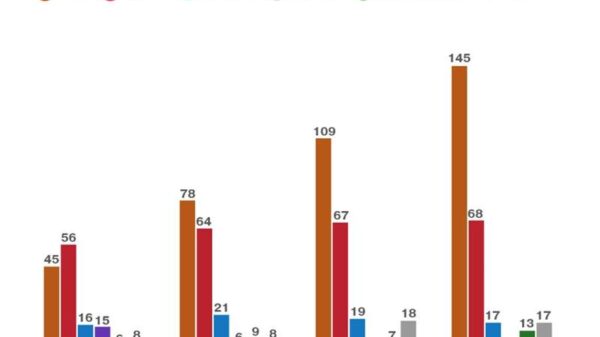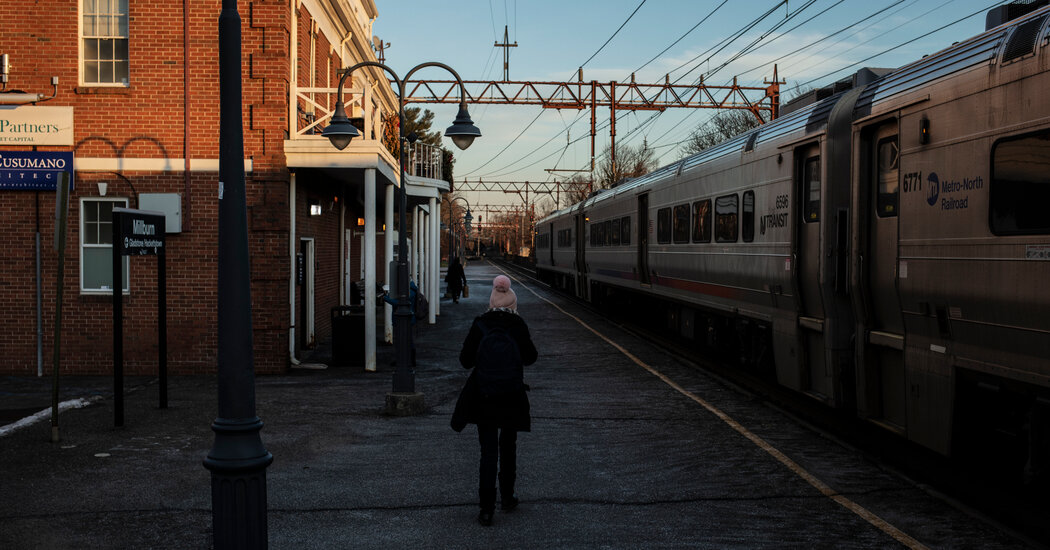Before the pandemic, they relied on office workers, who paid up to $500 a month on tickets. At the M.T.A., those sales are down 75 percent.
Before the coronavirus pandemic, more than a million workers commuted into New York City every weekday.
Now, with the public health crisis entering its third year and another variant upending the rhythms of the city, employers increasingly view the five-day workweek in the office as a relic of the past, adopting more flexibility because their employees are demanding it.
The absence of office workers has dealt a brutal blow to restaurants, stores and other businesses that depend on them. But it has been particularly devastating for the public transit systems in the region, where before the pandemic more people used subways, commuter rails and buses than in any other part of the country.
In 2019, the regional transit agencies collectively carried more than 500 million passengers across the New York area but ridership in 2021 declined by more than half of that prepandemic level.
Through wave after wave of coronavirus infections, transit officials have remained steadfast in their belief that commuters would soon return to regularly riding trains and buses.
But each new variant has dealt a disappointing setback as employers repeatedly postpone plans for a return to offices. Uncertainty about how the pandemic will play out has left transit officials guessing about when and to what degree commuters will revert to their previous routines — if they ever do.
Commuter rails, even more so than the subway, are particularly dependent on office workers flowing into New York from Long Island, New Jersey and suburbs north of the city.
The Omicron variant, which swept through the region at the end of last year, reversed what had been a slow but steady increase in commuting. Before the December holidays, weekday ridership had surpassed half of prepandemic levels on the region’s commuter systems and had even exceeded some forecasts for the year.
But since then, trains and buses have started emptying out again. Subway ridership, which had been nearing 60 percent of prepandemic levels, has dropped to below 50 percent. The commuter railroads sank to less than 40 percent of their prepandemic loads.
Despite the drop, transit agencies are still clinging to ridership projections that are generally on the high side: Metro-North Railroad and the Long Island Rail Road expect their ridership to reach at least 74 percent of prepandemic levels in 2022. The operators of the PATH train that links northern New Jersey to Manhattan, forecast 80 percent. And New Jersey Transit predicts 76 percent by mid-2023.
But those projections are built more on hope than certainty, said Christopher Jones, a senior research fellow at the Regional Plan Association, an influential research and advocacy group.
“You know that people are not going to be traveling into the office as much as they were.” Mr. Jones said. “But you don’t know what those patterns are going to be yet.”
To gauge how ridership might recover, transit agencies have hired consultants and surveyed riders. But those methods are susceptible to the vagaries of the virus. In June, more than 90 percent of New Jersey Transit commuters to the city who were surveyed said their employers were planning a return to the office by September.
Then, the Delta variant arrived and disrupted most return-to-office plans. New Jersey Transit surveyed its customers again in November but has not yet shared the results. The Port Authority of New York and New Jersey is surveying users of its PATH train system to test its theory that they will return in droves this year.
Office workers are an especially vital financial lifeline because many of them bought monthly passes, which cost $500 or more every month, and supplied the agencies with steady and substantial revenue.
But now many commuters have given up their passes and with many companies shifting to more flexible or hybrid schedules, it is not clear when or if the demand for the passes will return to prepandemic levels.
The Metropolitan Transportation Authority’s two commuter railroads, Metro- North and the Long Island Railroad, sold nearly 200,000 monthly passes before the pandemic. In November, those sales were down more than 75 percent, to about 45,000 passes. The authority recently said that it would collect just $49 million from commuters in 2021 — a steep decline from $346 million in 2019.
Sales of monthly passes accounted for nearly 40 percent of New Jersey Transit’s ticket revenue in 2019. In mid-2021, sales of those passes were still down by about 70 percent.
The commuter agencies have largely avoided drastic cuts with the help of billions of dollars in federal assistance during the pandemic.
Before the pandemic, Tero Jänne spent two hours every workday traveling on Metro-North between his home in Darien, Conn., and his office at Solomon Partners, a financial firm in Midtown Manhattan. He gave up his monthly pass, which cost $335, and before Omicron arrived, commuted into work about three days a week.
“I don’t view it as a reduced workweek — it’s a reduced period of commuting,” said Mr. Jänne, a managing director at the company.
Nearly everyone at Solomon Partners, including its executives, have reduced the number of days they visit the office as part of a permanent shift to hybrid work. Senior bankers have lost their offices, which have been converted into shared meeting spaces.
“The notion that people are pounding the table that we go back to the way we worked is outright wrong” said Marc Cooper, the company’s chief executive, who now is in the office two to three times per week. “I certainly don’t need my partner and my senior bankers who are outwardly focused to come into the office and make phone calls.”
A recent survey by the Partnership for New York City, which represents big employers, found that nearly half of companies expected some of their workers to to be in the office only two days a week even after the pandemic ends.
The biggest employers, which employ more than 500 people, expected less than half of their workers to return to offices before the end of January. But that was before the Omicron variant arrived.
“We’re about to find out what the new year is going to bring.” said Janno Lieber, the acting chairman and chief executive of the Metropolitan Transportation Authority. “We are a $16 billion business that has lost half its customers and we are going to go out there and get them back.”
Even as transit officials insist that the commuter railroads will start bouncing back in notable numbers this year, the agency is also acknowledging that the pandemic is more and more likely to lead to permanent changes in the region’s commuting pattern.
The M.T.A.’s board has approved the sale of tickets that will be good for 20 rides over 60 days, at a 20 percent discount from peak one-way fares. They would cover five round-trips per month. The board also approved a temporary discount of 10 percent on monthly passes.
Metro-North was selling about 95,000 monthly passes before the pandemic, Mr. Lieber said. That number plunged to about 10,000 by the start of 2021 and gradually rose to about 20,000 by November, he said.
“Obviously, we are trying to incentivize the hybrid worker to come back to mass transit,” Mr. Lieber said.
Before the pandemic, Phil Pescatore, the chief ethics officer at Guardian Life Insurance Company of America, traveled almost every day from his New Jersey home to the company’s office at Hudson Yards on the Far West Side of Manhattan — three hours commuting round trip every day.
When the pandemic started, Guardian already had a hybrid work model, adopting a flexible schedule for some employees after Hurricane Sandy in 2012 damaged its former office in Lower Manhattan. But as the pandemic has persisted, the company decided to give even more flexibility to employees, including the option for some new hires not to visit the office at all.
Mr. Pescatore has given up his monthly pass on New Jersey Transit and now buys individual tickets.
“It’s been found time, and I have repurposed that time,” Mr. Pescatore said. “I do things that I hadn’t had a chance to do: a bit more exercise in the morning, and the ability to think and plan a little bit more.”
Not only does David Kass, a book publicist, have no intention of returning to commuting regularly to an office in Manhattan, he no longer has an office there.
Mr. Kass, who lives with his wife and two children in Verona, N.J., has been working from home since the pandemic started. About a year ago, his small firm decided to abandon its office space in the Flatiron district and go “completely virtual,” he said.
After years of riding New Jersey Transit trains back and forth to Pennsylvania Station daily, Mr. Kass, 45, rarely boards a train and does not miss depending on a railroad that had become maddeningly unreliable.
“It’s the commute that I dread,” Mr. Kass said. “It’s the commute that was eating me alive.”
Now that he is saving more than $300 a month on a monthly pass and at least a couple of hours a day by skipping the commute, he is a work-from-home convert.
“You can’t tell me I have to commute into an office,’’ he said, “if I have 100 percent demonstrated that this works.”




























